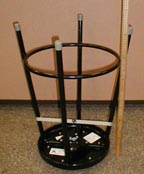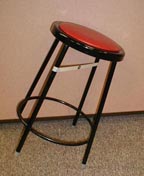
The center of mass of a stool, red dot, will be directly below the point of suspension.
Ken Finn balances a stool to find the center of gravity
click for a larger image.
Forbidden transition
Introduction
A stool can be used to model the energy levels of an atom.
Material
To Do and Notice
Find and mark the center of mass of the stool.
(When the stool hangs horizontally from one finger hooked around a leg then the center of mass of the stool is straight below your finger. Due to the symmetry of the stool the center of mass is on a line through the center of the seat of the stool. Mark the center of mass by stretching masking tape between the legs.)
The center of mass of a stool, red dot, will be directly below the point of suspension.
Ken Finn balances a stool to find the center of gravity
click for a larger image.
Place the stool on the ground in the normal
position.
Measure the height of the center of mass.
Put the flat top of the stool against the
ground.
Measure the height of the center of mass.

Notice that the position of the center of mass is lowest when the massive top of the stool is on the ground. The lowest position of the center of mass is called the ground state of the stool.
When the stool is in its normal position the center of mass is higher than the ground state, so the gravitational potential energy of this excited energy state is higher than the ground state. The center of mass of the stool in the photos was 45 cm above the ground in this excited state.
Put the stool back into the ground state. Lean it up on one edge and balance it as best you can. Let Go.
Notice that the center of mass of the stool is higher than the ground state, it is an excited state. The better you balance the stool, the longer it will live in the excited state. Notice that when you let go, the excited state returns to the ground state with the emission of a noise.
Put the stool in its normal position and balance it by tipping it to the side on two legs. To do this you must raise the center of mass. From this balanced position the stool can decay to its normal position. It may also decay to its ground state position. By observing the decay of this state can you find another energy level?

What's Going On?
The stool models the behavior of an atom. An
electron in an atom can exist in discrete states each of which has a
specific energy.
For example, in a hydrogen atom the lowest energy, or ground state,
is called the 1s state.

A few of the energy levels for a hydrogen atom, and a few of
the energy levels for a stool
When you balance the stool on an edge you raise it
in to a higher energy excited state which can decay into the ground
state. It is theoretically possible for this state to have a long
life. The stool will balance with the center of mass at only a few
precise heights. It will never balance at positions between these
heights.
An electron in an atom can only exist in certain fixed energy levels.
It cannot exist with energies between these energy levels.
A higher energy level stool can sometimes return
to the ground state with the emission of noise.
A higher energy electron can return to the ground state with the
emission of a photon of light.
However, for both the stool and the atom, there are higher energy states that are very long lived. In its normal position the stool does not spontaneously fall into the ground state. An atom in the higher energy 2s state cannot decay into the ground state by emission of a photon. The change from the 2s to the 1s state is called a "forbidden transition." It does not occur in gasses in the laboratory. Since these state cannot easily decay, they have long lives and are called "metastable" states.
By leaning the chair to the side from its normal
position you enter an excited state which can decay back to the
normal position or into the ground state.
In an atom you can excite an electron from the 2s to the 2p state,
the electron will decay from the 2p to the 1s state.
There are energy levels for the chair when it is laying on its side. These energy levels show that the chair has energy level patterns which are not exactly like those of atoms. For a chair with a square top the energy level of the chair lying on its side can be achieved in 4 different orientations, one state for each of the sides against the floor. For each of these orientations the chair has the same energy. The resulting energy levels are said to be degenerate.
Chairs are not atoms.
You can investigate the simpler energy levels of a croquet mallet or a hammer. It is easier to find the center of mass of a mallet than the center of mass of a stool, simply balance the mallet on a finger. The croquet mallet has a ground state, one excited state with the handle up and the mallet down, one higher excited state with the mallet up and the handle down, and another excited state in-between these, can you find it? Is the excited state with the handle up metastable?
Etc.
Glowing gas clouds in space glow with light from forbidden transitions. The atoms in space suffer collisions so infrequently that even the rare forbidden transitions have time to occur and emit light. Even though the gas clouds are very low density, better than all but the best vacuums in laboratories on earth, they may be light years thick. The tremendous thickness allows them to emit enough light to be seen. If you look up at the dagger in the constellation of Orion the middle star is not a star at all but a nebula, the Orion Nebula, glowing with the light of forbidden transitions.
|
Scientific Explorations with Paul Doherty |
|
24 May 2000 |